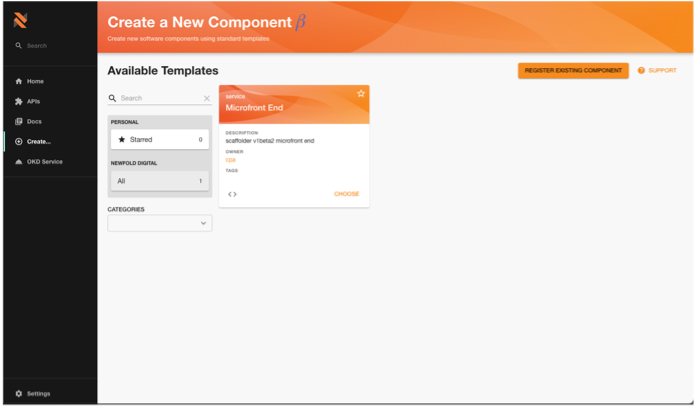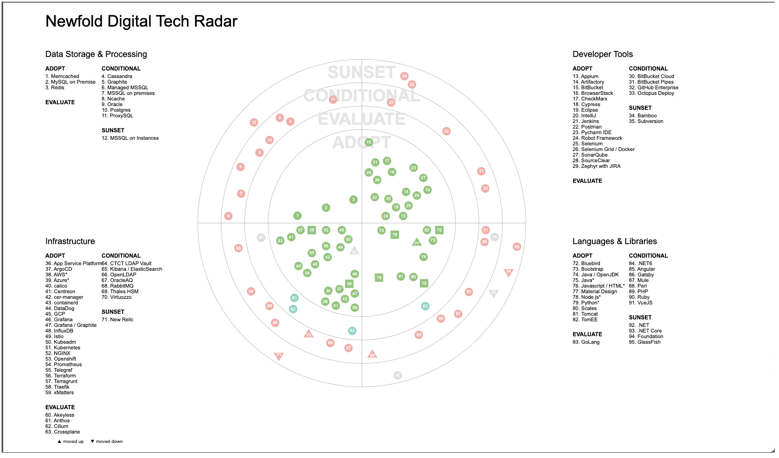Welcome to the inagural issue of the “Developer Platform Zone”. This quarterly newsletter will keep you informed about development efforts being undertaken by the Developer Platform Team.
Wanda (Engineering Portal) Production Ready

The production release of Wanda (Engineering Portal) is available for use. Wanda uses SSO so sign in is straight forward. The first version of the new Microfront End template is also available. This template has all the libraries and test cases needed to start development of a new MFE. To access the template, click the “Create Component” button on Wanda’s Home screen, then click “Choose” on the MFE template and fill in the forms. When the process completes a new repo will be available in BitBucket containing the base MFE files.
If you would like help or more information on how to add your project(s) to the portal, please contact Chuck Williams.
Wanda is available at https://wanda.svcs.newfold.com
New Tech Radar

The Developer Platform Team has released an updated version of the Newfold Digital Tech Radar.
What is the Newfold Digital Tech Radar?
As part of evolving our technology stack we need to drive to common technologies at various layers of the application and cloud stack. This helps us with:
- Code and staff flexibility— team members should be able to understand code that wasn’t written by their group and be able to propose pull requests for enhancements. We also want to keep our teams flexible and be able to have components move ownership to help facilitate changes in direction over time.
- Easier training — by having a set “menu” of technology options, we can drive common training and expertise across the Newfold engineering team.
- Easier oversight — we help our support teams (like the application security team, database operations team, CI/CD team, Cloud Team, etc.) provide us with better service by using common sets of technology. The Tech Radar is available here: Newfold Digital Tech Radar
Please contact Chuck Williams if you would like to create a Team radar or recommend changes/additions to the Tech Radar.
New CI/CD Pipelines

Change is evolution, and we aim to help teams evolve and thrive as technology advances. We are working on building new CICD models based on Jenkins Pipelines using our Jenkins Shared Library which defines a set of templates for different types of projects. We will have standard workflows that include several compliance stages for building and deploying containerized applications securely and automatically. These stages will include:
- Automated testing
- SonarQube checks
- Smoke/integration tests
- Veracode scans
- Lacework scans
- Integration with our Change Management System (Service Now)
- Integration with AWS, OKD, etc.
The pipeline will allow deployments to be executed on k8s clusters either cloud or on premise. The final goal is to be able to provide those templates to be consumed directly from Wanda portal.
The team is already supporting a previous version of the pipeline templates for teams migrating Jarvis components to containerized applications running on k8s. We continue to work on helping the transformation as we define new standard ways of achieving automation throughout the SDLC.
New Jarvis PCI Kubernetes Clusters

As part of the effort to reduce the scope of PCI in production for Jarvis, there are now two Jarvis Kubernetes clusters dedicated to run services that are in PCI scope:
- stg1pcik8s01 (Staging) and
- atl4pcik8s01 (Production).
Both clusters are currently available.
- Information for both stg1pcik8s01 and atl4pcik8s01 is available in the Jarvis Kubernetes clusters Inventory.
- Information about which Jarvis Kubernetes applications are in PCI scope is available on the Jarvis Kubernetes applications Inventory.
- There are two production clusters, atl4k8s01 and atl4pcik8s01, and two staging clusters, stg1k8s01 and stg1pcik8s01.
One major change planned for the production clusters will achieve complete VLAN separation.
Jarvis Production cluster increased CPU capacity
The production Jarvis cluster atl4k8s01 has doubled its CPU capacity. This was achieved by adding more Virtual CPUs to the existing worker nodes in the cluster. Additional capacity was added with 50% more worker nodes. The new nodes are not yet active (cordoned) as we work with NetOps and Infrastructure teams to make sure they have the same connectivity as the existing nodes including being able to mount NFS storage available to all worker nodes. We plan to work with development teams to reduce the gap between CPU requested and actual CPU used in applications to reduce the possibility of idle resources. Meanwhile the qa1k8s cluster capacity was increased by adding one additional node.
